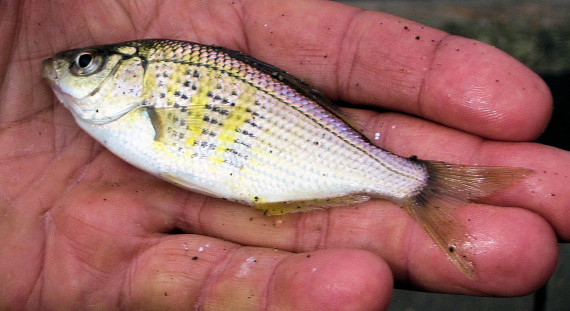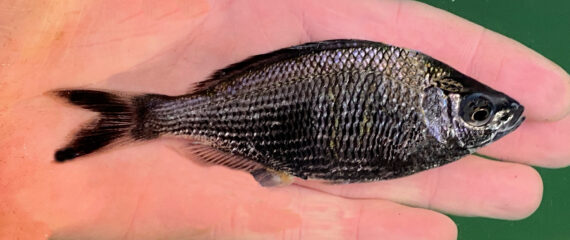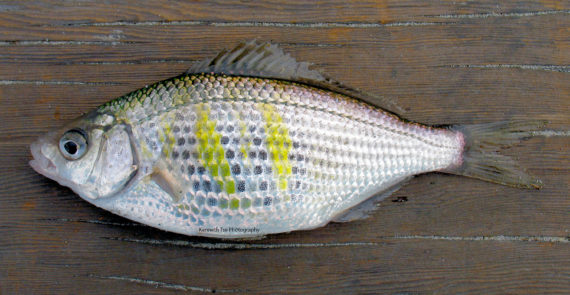Shiner Perch, Cymatogaster aggregata
 Shiner Perch, Cymatogaster aggregata. Fish caught off the beach at Newport, Oregon, June 2021. Length: 10 cm (3.9 inches). Catch, photograph and identification courtesy of Luke Ovgard, Klamath Falls, Oregon.
Shiner Perch, Cymatogaster aggregata. Fish caught off the beach at Newport, Oregon, June 2021. Length: 10 cm (3.9 inches). Catch, photograph and identification courtesy of Luke Ovgard, Klamath Falls, Oregon.
 Shiner Perch, Cymatogaster aggregata. Fish caught off the Coos Bay Pier, Coos Bay, Oregon, August 2009. Length: 10.0 cm (3.9 inches).
Shiner Perch, Cymatogaster aggregata. Fish caught off the Coos Bay Pier, Coos Bay, Oregon, August 2009. Length: 10.0 cm (3.9 inches).
 Shiner Perch, Cymatogaster aggregata, Breeding Male. Fish caught from within the Ventura Harbor, Ventura, California, October 2008. Length: 12 cm (4.7 inches). Catch, photograph and identification courtesy of Luke Ovgard, Klamath Falls, Oregon.
Shiner Perch, Cymatogaster aggregata, Breeding Male. Fish caught from within the Ventura Harbor, Ventura, California, October 2008. Length: 12 cm (4.7 inches). Catch, photograph and identification courtesy of Luke Ovgard, Klamath Falls, Oregon.
 Shiner Perch, Cymatogaster aggregata. Fish caught off the Santa Monica Pier, Santa Monica, California, June 2016. Length: 12.7 cm (5.0 inches). Catch, photograph and identification courtesy of Ryan Crutchfield, Tampa, Florida.
Shiner Perch, Cymatogaster aggregata. Fish caught off the Santa Monica Pier, Santa Monica, California, June 2016. Length: 12.7 cm (5.0 inches). Catch, photograph and identification courtesy of Ryan Crutchfield, Tampa, Florida.
 Shiner Perch, Cymatogaster aggregata. Fish caught off the Municipal Wharf #2, Monterey, California, August 2012. Length: 15 cm (6.0 inches). Catch, photograph and identification courtesy of Kenneth Tse, Toronto, Ontario, Canada.
Shiner Perch, Cymatogaster aggregata. Fish caught off the Municipal Wharf #2, Monterey, California, August 2012. Length: 15 cm (6.0 inches). Catch, photograph and identification courtesy of Kenneth Tse, Toronto, Ontario, Canada.
The Shiner Perch, Cymatogaster aggregata, is a member of the Surfperch or Embiotocidae Family, that is also know as the Shiner Surfperch and in Mexico as mojarra brillosa. They str the only member of the genus Cymatogaster, the fish described herein, which is found in Mexican waters of the Pacific Ocean. The Shiner Perch are of scientific interest as they are one of the 15% to 20% of all living fish that are labriform swimmers. They use their pectoral fins rather than their caudal fin for swimming and flap their fins much like swimming penguins.
The Shiner Perch has a highly compressed elongated “football-shaped” fusiform oval bodies with a typical “perch-like” shape and a depth that is 33% to 37% of standard length. They are silvery and have a dusky greenish back with fine horizontal bars and three broad yellow vertical bars on their sides. They have fine black dots on their sides toward their head. Their anal, pectoral, and pelvic fins are transparent; their caudal and dorsal fins are transparent to dusky. Breeding males are black and covered with dark speckles. Their anal fin has 3 spines and 22 to 25 rays; their caudal fin is forked; and their dorsal fin is continuous with 8 to 11 spines and 19 to 22 rays. They have 28 to 33 gill rakers. Their body is covered with large scales. Their lateral line is slightly arched and complete.
The Shiner Perch is found in heavily vegetated and structured shallow water bays and estuaries within eelgrass beds. They are often found in large schools around piers and jetties and in adjacent brackish and fresh water systems. The Shiner Perch are found demersal in tidal pools and in the surf zone at depths up to 145 m (480 feet). They reach a maximum of 21.0 cm (8.3 inches) in length with males and females being of equal length. They reside in waters that range from 7oC (45oF) to 24oC (75oF) and are absent from waters above 25oC (77oF). They are diurnal feeders, with juveniles consuming zooplankton, such as copepods, then transitioning to algae, crustaceans, and mollusks as they mature. Reproduction is viviparous and occurs in November and December with males exhibiting an elaborate courtship toward females. Gestation lasts 5 to 6 months with each female producing 3 to 36 fry measuring 3.0 cm (1.2 inches) to 4.0 cm (1.6 inches); larger females produce larger litters. Females carry the developing young until they mature. They are generally non-migratory, but will make seasonal inshore-offshore movements; they will move to deeper waters during the winter and pregnant females will move to shallow waters in the spring to give birth. They have a lifespan of up to nine years.
The Shiner Perch is a resident of Mexican waters of the Pacific but has a limited distribution being found only from Bahia San Quintin, Baja California, northward along the northwest coast of Baja
The Shiner Perch is straightforward to identify due to its elongated body profile and coloration and is therefore not easily confused with any other species.
From a conservation perspective the Shiner Perch is currently considered to be of Least Concern with stable, widely distributed populations. They are caught during the summer months in abundance in various locations along the west coast of the United States on small hooks and light tackle utilizing shrimp, small pieces of fish, small crabs, squid, and dough. They are especially popular among beginning anglers as they are abundant and easy to catch. They are, however, a minor component of the pier fishery. They are sold commercially on a limited basis. Although exceedingly small, they are considered an excellent food fish. They can also be found in public aquariums and are used on occasion as bait fish for larger prey.